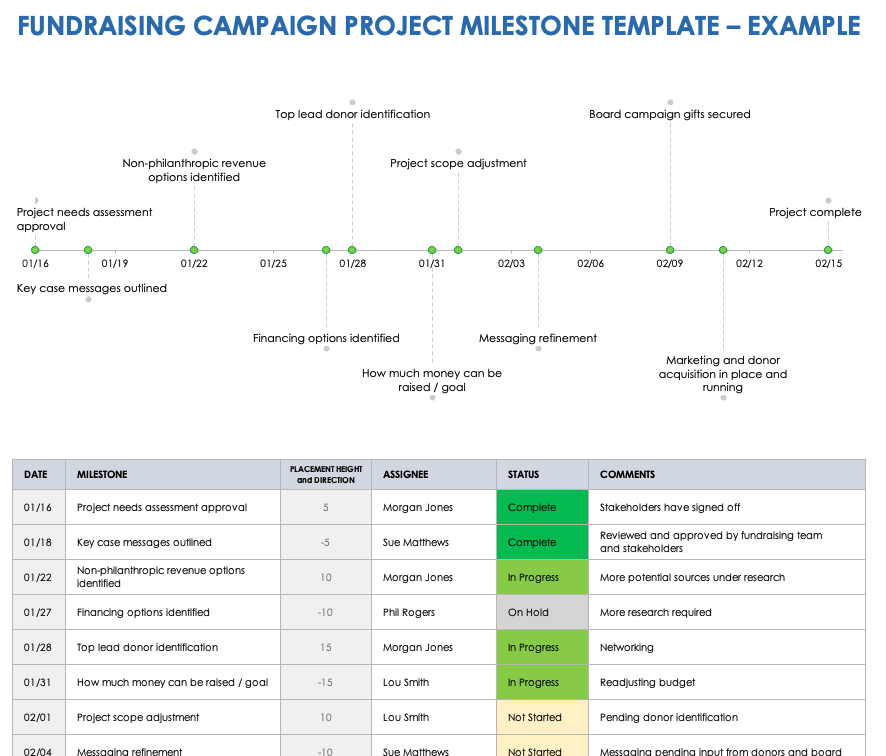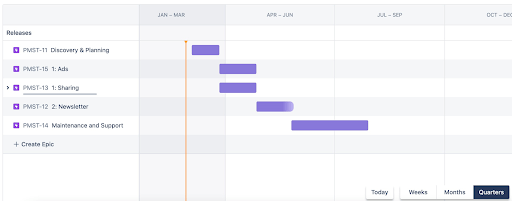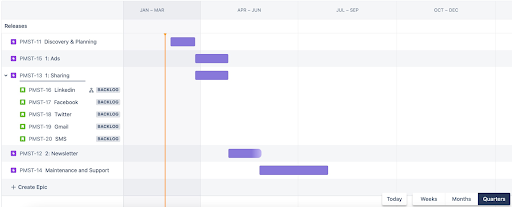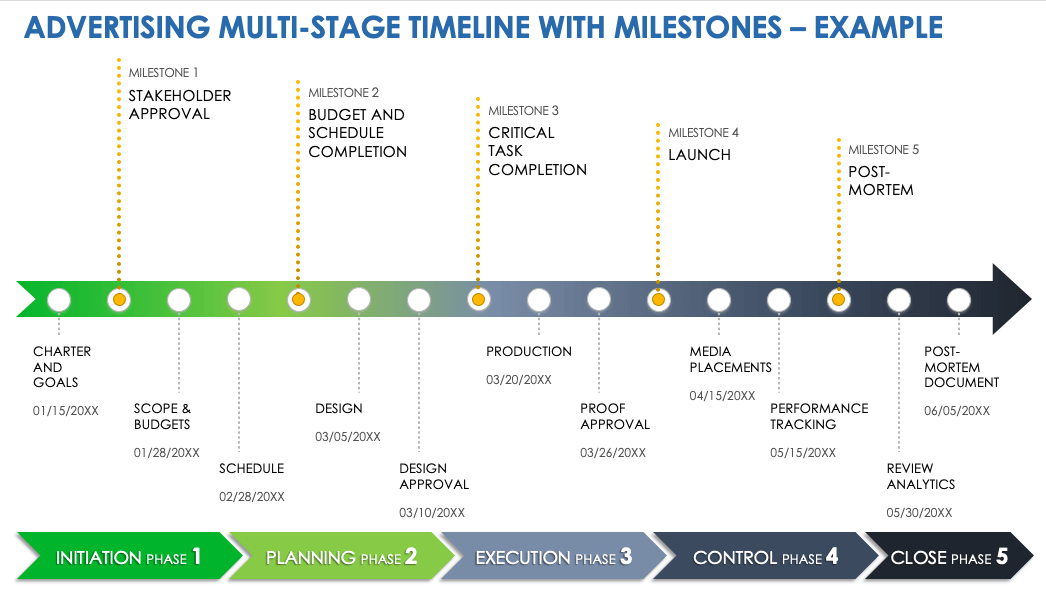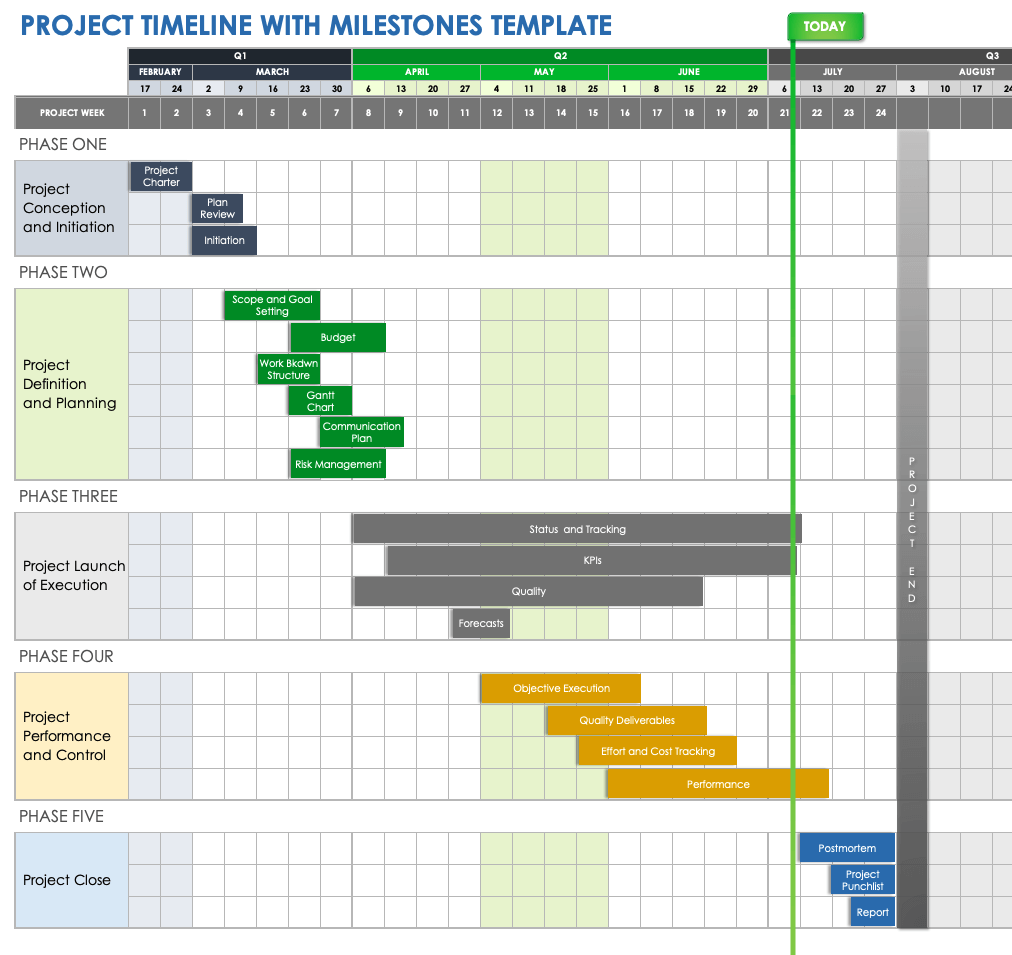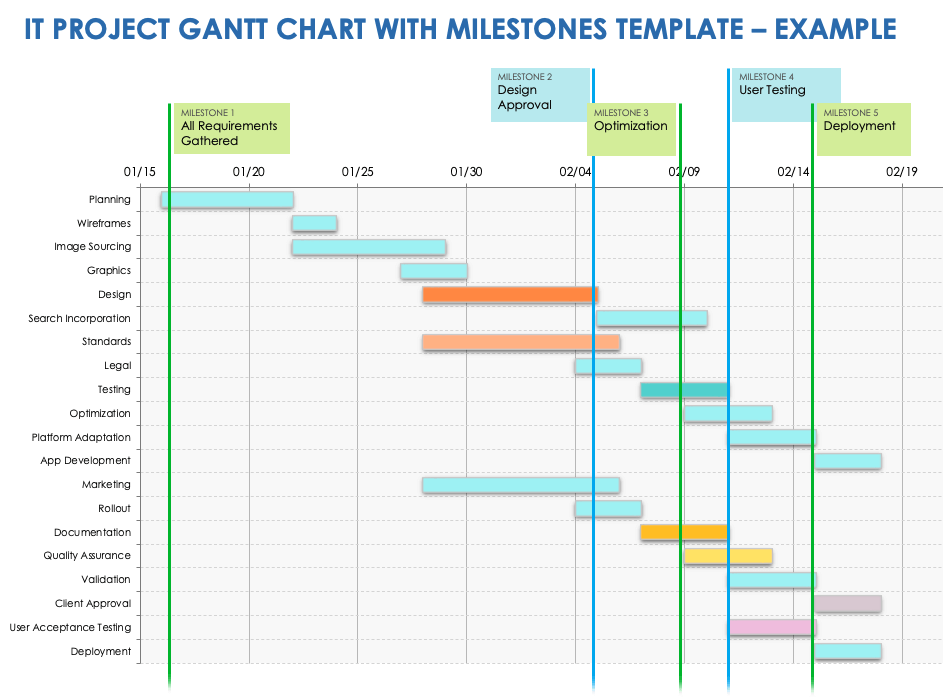What Are Project Milestones?
A project milestone is a specific point in a project timeline that signifies a major achievement or development phase. Project managers use milestones to track progress and ensure that goals are being met in a timely manner.
Author Jon M. Quigley, Founding Member and Principal of the product development and cost improvement organization Value Transformation, underscores the value of these markers. “Milestone project management helps teams track progress, provides a sense of accomplishment, and enables effective communication among project stakeholders,” he explains.
Similarly, Kristina Kushner, PMP and Delivery Manager at Brainly, elaborates on the importance of using milestones: "Project milestones are an important tool that break a project schedule into more manageable portions. They can represent any phase of work, from completing a specific goal to the project's close.”
Within project management, milestones play a pivotal role in propelling individuals, departments, or entire organizations toward meeting targets in key result areas (KRAs). These positive outcomes are instrumental in advancing the organization’s strategic vision.
Project milestones are also an important project control, providing clear checkpoints for monitoring progress, ensuring tasks are completed on schedule, and validating that objectives are met at specific intervals.
How Many Milestones Does a Project Have?
The number of milestones a project has can vary greatly depending on the project's complexity, length, and specific objectives. There is no standard number, but it's crucial to designate milestones that signify significant progress and achievements within the project.
How Are Milestones Used in Project Management?
In project management, milestones mark specific achievements or goals to be reached at predetermined points in the project timeline. They serve as focus points, guiding teams in planning, scheduling, and tracking progress throughout the project's lifecycle.
These are some of the functions that milestones serve in project management:
- Scheduling: Project managers use milestones to signify key events or achievements in project schedules, providing clear checkpoints to track progress and ensure that project phases are being completed on time.
- Monitoring and Controlling: In projects with extensive tasks, long timelines, and large teams, it's easy to inadvertently overlook crucial items. Milestones act as project control checkpoints, ensuring every aspect of the project lifecycle is recognized and addressed.
- Preventing Scope Creep: Projects can become bloated with delays, cost overruns, and alterations when there's insufficient initial planning and documentation. Effective use of milestones streamlines the planning process to avoid scope creep.
- Achieving KRAs and KPIs: While milestones differ from metrics such as KRAs and KPIs, attaining a project milestone should bring an organization closer to its measurable targets.
- Reducing Risk: By determining which tasks need completion by certain dates or phases, project managers can identify and incorporate risk factors into the planning phase.
Here are some ways various people will use project milestones:
- Stakeholders: Milestones offer stakeholders — including team members, clients, and management — a way to monitor progress and updates. They foster improved communication and collaboration among team members and stakeholders.
- Clients: For clients, milestones instill confidence in the project's management. They allow clients to observe progress and address concerns as they arise.
- Project Managers: Milestones equip project managers with tools to monitor schedules, deadlines, KRAs, and KPIs. Achieving consecutive milestones provides a clear picture of the project's progression relative to its plan.
- Team Members: By setting a definitive course, milestones help team members concentrate on overarching objectives, ensuring they aren't overwhelmed by task-specific details.
Alan Zucker, Founding Principal of Project Management Essentials LLC, emphasizes the importance of milestones. “Project schedules often have hundreds or thousands of lines,” he explains. “Milestones can easily summarize the overall project performance into a few dozen critical checkpoints or deliverables. They allow the project team and primary stakeholders to track performance at the appropriate level of detail. Milestones can help primary stakeholders focus on the right things in the project and avoid getting lost in the details or noise.”
Project Milestone Excel Template
Download the Example Fundraising Campaign Project Milestone Template for Excel
Download the Blank Fundraising Campaign Project Milestone Template for Excel
Use this comprehensive template with or without sample data for tracking milestones on both static and timeline charts. Clearly indicate the owner of each task — whether an individual or team — the task's current status, and any other relevant comments on the task. The status row displays tasks as either to start, in progress, on hold, or completed. Download either a blank template or an example template pre-filled with sample data from a small manufacturing firm launching a new product.
Why Are Project Milestones Important?
Project milestones are important because they provide clear reference points, marking significant achievements or phases in a project timeline. They aid in tracking progress, facilitating effective planning and communication, and ensuring that project goals are met in a timely manner.
Milestones play a pivotal role in various aspects of project management, such as these:
- Accountability: Milestones are the checkpoints that help everyone involved in a project remain accountable for their contributions to the project's success.
- Allocation of Time and Resources: By using milestones, managers can distribute both human and other resources more efficiently, ensuring projects are delivered on time and within budget.
- Deadline Monitoring: With milestones in place, it becomes easier to see when deliverables and high-priority tasks — such as payments, reviews, or approvals — are due, ensuring that nothing is missed as the project progresses.
- Demonstration of Success: Achieving milestones demonstrates progress, showcasing to teams, management, stakeholders, and clients that the project is being conducted well.
- Identification of Potential Bottlenecks: Milestones help teams identify potential bottlenecks. If the project is behind schedule, these markers assist in reallocating resources or adjusting the schedule to ensure timely project completion.
- Motivation: Achieving milestones provides a sense of accomplishment. This not only keeps teams motivated but also offers clarity and direction.
- Trust Building: Milestones are important tools in project management that help teams navigate unpredictability and foster trust. By setting clear milestones, teams demonstrate commitment and transparency, ensuring that stakeholders stay informed throughout the project’s planning and execution.
What Makes a Good Project Milestone?
A good project milestone is a clearly defined and measurable progress point that acts as a stepping stone toward achieving the end goal. It should be easily visible and understood by stakeholders, ensuring alignment and celebration of important achievements.
Here are the five common characteristics of good project milestones:
- Specific: A good project milestone leaves no ambiguity about what needs to be achieved. “Project milestones are clear and well-defined, representing a significant achievement or completion of a specific task, phase, or deliverable,” says Quigley.
- Meaningful: Milestones should have significance in the project's journey, marking important achievements. “They denote key moments or turning points in a project's lifecycle,” explains Quigley, “highlighting major accomplishments or decisions that contribute to the overall success of the project.”
- Progressive: Each milestone acts as a stepping stone, building upon the previous one and leading the project closer to its end goal. “Milestones are associated with a specific date or time frame,” says Quigley. “They act as checkpoints to assess project progress against the planned schedule and ensure timely completion.”
- Measureable: It should be possible to objectively assess whether or not the milestone has been reached, using clear criteria or metrics.
- Visible: Stakeholders and team members should be able to easily see and understand the milestone's status and its relevance to the project's progression. “Communicate and share milestones with project stakeholders to ensure transparency and alignment,” recommends Quigley. “Milestones are reference points for progress reporting, communicating updates, and managing expectations. Comparing actual progress to milestones enables making adjustments if needed, replanning the project, or even canceling depending upon the gap between goals and where the project is relative to set milestones.”
Project Milestone Examples
Examples of project milestones include finalizing a project charter, completing a prototype, or securing vendor contracts. Many milestones also mark the transition between project phases, such as securing stakeholder approval, budget and schedule completion, and final launch.
Milestones break projects into stages, typically highlighting the five phases of the project lifecycle. However, multiple milestones within a phase might make sense, depending on the project and the manager. Key decision-makers should review every milestone to ensure their necessity as part of the schedule.
Here are examples of milestones that mark the conclusion of the five project phases:
- Stakeholder Approval: Once stakeholders have signed off on a project's feasibility, scope, and objectives, it marks the end of the initiation phase. This milestone signifies that the project has the green light to proceed.
- Budget and Schedule Completion: Once teams have developed and finalized a detailed budget and a timeline, defining resources, costs, and key dates, it marks the end of the planning phase. The work outlined in the project plan can begin in earnest.
- Critical Task Completion: Once critical tasks are complete, such as completing a software beta-test or securing a vital permit, it marks the end of the execution phase. The team can now begin watching performance metrics to ensure that the project stays on track.
- Product Launch: Once your service, website, or other product goes out into the world, it marks the end of the control phase. It signifies the operational handover of the deliverable.
- Post-Mortem: Once you’ve conducted your project post-mortem, it marks the end of the close phase. It signifies the formal conclusion of the project.
Here are five examples of milestones that might occur within a project phase:
- Site Inspection Approval: Before construction can begin, a site inspection is often required to meet local codes and regulations. This milestone is crucial, as it verifies that the project is compliant, reducing legal and safety risks.
- First Patient Enrolled: In clinical trials, the enrollment of the first patient is a significant step, marking the transition from the preparatory phase to active data collection. This milestone ensures that the trial is proceeding on schedule.
- Software Alpha Testing: Before a software product is released to the wider public, it goes through alpha testing, typically conducted internally. This milestone confirms that the initial development is complete and the product is ready for preliminary testing and feedback.
- Manuscript Acceptance: After an author submits a manuscript to a publisher, it undergoes a review process. When accepted, this milestone signifies that the content meets the publisher's criteria and is ready for editing, design, and printing.
- Initial Design Review: An initial design review evaluates the feasibility and functionality of a proposed product. This milestone is pivotal as it confirms that the design aligns with project requirements and can proceed to engineering.
Case Study: Increasing Website Traffic With Project Milestone Scheduling
Project milestone scheduling can help teams prioritize tasks for website growth, such as content creation, SEO optimization, and marketing campaigns. By setting and achieving these milestones, one ensures a systematic approach to increasing website traffic.
“This case study illustrates how I set high-level milestones for a small or repetitive project with a low probability of changes and risks,” says Kushner. “We want to keep clients apprised of milestones — however, in this case, not necessarily with all the details for every aspect.”
- Challenge: Double the number of visits to our app.
- Method: Undertake these preparatory steps to shape our strategy:
- Set the Goal: Kushner emphasizes the significance of a clear target: “The goal is the criteria we measure the project success against, with milestone planning as a tool.”
- Decide on Objectives: This entails breaking down the individual steps needed to achieve the goal. “In this instance, we could create newsletters, implement sharing features, and set up ads on other platforms to bring new visitors,” says Kushner.
- Conduct Discovery: This phase involves in-depth analysis and preliminary estimates to assess the best approaches or app features.
- Solution: To address the challenge, outline multiple deliverables, such as these:
- Designate Deliverables: Kushner highlights the importance of identifying deliverables. “A deliverable is a completed standalone piece of work that is presented to the stakeholders and helps get closer to completing one of the project objectives,” she states. “After discovery, we decided on sharing features, ads, and newsletters.”
- Create the Schedule: Kushner describes the coordination involved in creating a schedule with milestones. “Implementing sharing features and setting up ads on other platforms are handled by different teams,” she says. “Newsletters would require the engagement of both of them, so we need to choose what will happen first.”
- Set Milestones: The process of setting milestones is integral for ensuring orderly progression. “The sharing features are in place on the schedule,” says Kushner. “With LinkedIn or SMS, we can individually demonstrate this project increment to stakeholders. Those increments are our deliverables within the first project milestone. Resources are assigned once we understand what’s required to get this LinkedIn sharing button on the screen. This portion of the project requires multiple individuals and SMEs since a designer will not write the code or execute the quality assurance work. Therefore, those activities are created as individual tasks and assigned to appropriate resources.”
- Result: The outcome is a comprehensive milestone planning schedule, allowing for continuous adjustments and evaluations in alignment with the overarching goal.
Advertising Project Milestones by Phase and Timeline Template
Download a Sample Advertising Project Milestones by Phase and Timeline Template for
Excel | PowerPoint
Download a Blank Advertising Project Milestones by Phase and Timeline Template for
Excel | PowerPoint
Each of the phases in marketing projects has at least one milestone signifying a significant progress point. This template with or without data simplifies your assignment, making it easier to identify milestones and their associated tasks. Stakeholders gain high-level insights into each milestone of your project, enabling them to track progress and address potential issues proactively. For further guidance, you can download the sample version of this template, or if you wish to start from scratch, download the blank version to fill out.
Common Project Milestone Misconceptions
Misconceptions about project milestones are common. Clearing up milestone misconceptions is easy when you know the difference between milestones and other project management components, such as project goals, deadlines, phases, inch pebbles, deliverables, and tasks.
| Term | Purpose | Time/Duration | Key Differentiator |
| Milestone | To mark a significant event or achievement in a project | Specific point in time | Represents critical success factors in the course of a project |
| Goal | To achieve a desired final result or outcome | Medium- to long-term | Broad, general intentions that are intangible and abstract |
| Deadline | To set the latest time or date by which something should be completed | Specific point in time | Implies a fixed end point with consequences for missing it |
| Project Phase | To delineate a distinct stage in a project’s lifecycle | Varies by phase and project | Identifies stages with unique purposes and deliverables |
| Inch Pebble | To break down large tasks into smaller, manageable subtasks | Short-term | Helps in breaking down complex tasks and monitoring progress |
| Deliverable | To produce tangible outputs from project tasks or activities | Upon completion of the associated task | Provides specific outputs that fulfill project requirements |
| Tasks | To specify a single piece of work needed for the project | Varies, but typically short- to medium-term | Outlines action steps for specified outputs |
Milestone vs. Goal
A milestone signifies a major achievement or event in a project. In contrast, a goal is a broader, more general outcome or result that one seeks to achieve, typically serving as the driving purpose of a project.
Milestone vs. Deadline
While milestones mark significant events or achievements in a project's timeline, they may or may not be tied to a deliverable. A deadline, on the other hand, indicates the final date or time by which a task must be completed.
Milestone vs. Project Phase
A milestone marks specific achievements or events within the project lifecycle, serving as checkpoints or markers of progress. A project phase is a broader segment of the project lifecycle with its own set of tasks, deliverables, and objectives.
There can be several milestones within a project phase. To learn more about each stage of a project’s lifecycle, see this guide to the five phases of project management.
Milestone vs. Inch Pebble
Milestones are significant events or achievements that indicate substantial progress within a project. Inch pebbles, however, are much smaller, detailed tasks or steps that break down larger tasks, acting as mini milestones to ensure progress at a granular level.
Milestone vs. Deliverable
A milestone signifies a major event or achievement in a project, and its accomplishment might not always result in a tangible or intangible output. Deliverables, however, are specific outputs, either tangible or intangible, that result directly from a project task.
Milestone vs. Task
A milestone acts as a marker indicating significant progress within a project, often tying multiple tasks together. A task is a singular piece of work or activity that needs to be completed, often contributing to a milestone or larger project goal.
How to Identify, Write, Set, Track, and Share Project Milestones
To identify and write project milestones, begin by working backward from your end goal. Determine the major tasks and subtasks required, identify necessary approvals, and pinpoint the beginning and end of each project phase.
Identify Project Milestones Using a Questionnaire
This questionnaire is designed to assist you in identifying crucial project milestones. By answering the following questions, you'll gain clarity on the essential elements of your project and ensure you stay on track toward achieving your end goal.
To use this questionnaire, simply fill in the blanks for each prompt:
| What is the desired outcome or end goal for your project? | |
| What are this project's risk factors? | |
| What are your key deadlines or significant dates? | |
| What are the main tasks needed to complete the project? | |
| What are the subtasks or smaller details needed to complete the project? | |
| What will mark the start and finish of each project phase? | |
| What approvals are needed for project progression? | |
| Who are the key stakeholders or individuals responsible for granting approvals? |
By responding to each of these questions, you'll be able to outline key milestones and establish a roadmap for your project.
How to Set and Write Project Milestones in Six Steps
To set and write project milestones, start by clearly identifying your end goal. Then list all project tasks, significant dates, and potential risks. Finally, prioritize all of these tasks and establish milestones for pivotal phase transitions and significant achievements.
- Define Your Goal: Clearly outline the primary goal or outcome you aim to achieve by the end of the project. Make sure you, your clients, team members, and key stakeholders all understand and agree on the primary goal.
- Break Down the Project: Once you know your end goal, list all the major tasks and related subtasks required to get to the finish line.
- Factor in Risks and Dependencies: Identify potential challenges, risks, or dependencies between tasks that could influence the timeline or sequence.
- Involve Stakeholders: Collaborate with key stakeholders, teams, or clients to ensure alignment, and gather their input.
- Prioritize and Allocate Resources: Once you’ve identified your goal, tasks, risks, and dependencies and sought stakeholder feedback, you can determine the importance and sequence of tasks and allocate the necessary resources, such as budget, equipment, and time.
- Set Milestones: Based on your task breakdown and priorities, designate milestones that indicate significant achievements or phase completions.
Tip: When setting milestones, remember to think through all the aspects of the project, especially for complex and long-term projects, and to engage the team and stakeholders throughout the process.
How to Track, Share, and Report Project Milestones
To track, share, and report milestones, the easiest method is to use collaborative project management tools. With a shareable document that can be updated or commented on, you’ll keep every stakeholder informed and engaged, streamlining processes and saving time.
Follow these steps to effectively track, share, and report project milestones:
- Select a Tracking Tool: Choose a project management tool, template, or software that allows you to set, monitor, and update milestones. To get started, try one of these free project milestone templates.
- Update Regularly: As the project progresses, make sure to consistently update milestones to reflect the project’s current status.
- Set Notifications: Implement automatic notifications or reminders for upcoming or achieved milestones to keep the team informed and aligned.
- Share With Stakeholders: Provide stakeholders with access to the tracking tool, or send regular milestone reports to keep them informed. Encourage team members and stakeholders to provide feedback on milestone progress to identify any potential adjustments or refinements.
- Compile a Periodic Report: Gather milestone data and produce a summary report for broader audiences or higher management, showcasing progress, challenges, and future steps.
- Archive Completed Milestones: Once a milestone is achieved, archive or mark it as complete, but keep a record for future reference and post-project reviews.
Project Timeline With Milestones Template
Download a Project Timeline With Milestones Template for
Excel | Smartsheet
Try this editable timeline template to plot your project milestones and their corresponding tasks. Present each task on an annual, quarterly, or monthly basis for clear segmentation and accurate tracking. The template includes color-coded tasks and phases for easier visualization. Emphasize key milestones to ensure the team remains on track to meet the overarching project deadline.
How to Use Milestones in Gantt Charts
In Gantt charts, milestones are represented as diamond symbols or other visual markers. Plot project milestones at specific points where major tasks are completed, or at the transition between phases, providing a visual reference for tracking progress and ensuring key objectives are met.
Note: A Gantt chart is a visual timeline that displays the duration of tasks and their sequences within a project. Gantt charts are the preferred tool for project managers using the waterfall methodology, a linear and sequential approach where each phase of a project must be completed before the next one begins.
IT Project Gantt Chart With Milestones Template
Download the Sample IT Project Gantt Chart With Milestones Template for Excel
Download the Blank IT Project Gantt Chart With Milestones Template for Excel
Use this template to guide IT projects, or any project that uses waterfall methodology, with a Gantt chart. Begin by creating a task list and its corresponding subtasks. After reviewing the deadlines, resources, and dependencies, assemble the schedule. Divide the tasks into phases, and use milestones to mark the transition between phases, ensuring the team stays focused and on schedule.
Project Milestone Best Practices
Using project milestone best practices allows managers to maintain control and keep teams on task. Effective strategies include reviewing risk factors, keeping milestones simple, and aligning milestones with the critical path.
Here are some best practices for setting project milestones, according to experts:
- Emphasize Collaboration: Collaboration is at the heart of setting effective milestones. “Project managers should collaborate with the primary stakeholders to establish the project milestones during the planning process,” notes Zucker. “There should be a clear agreement that the milestone list represents the items stakeholders want to track. Milestones should have a set due date, an owner, and well-defined acceptance criteria. Project reporting should be tied to those milestones to inform stakeholders of progress toward meeting these major project objectives.”
- Prioritize Business Goals: Business goals should guide every milestone's intent. “Think of the business goals. Why are we creating this, and what problem are we solving?” asks Kushner. Each milestone result should contribute to achieving these goals.
- Regularly Review Risk Factors: Regular assessments of risk can mitigate potential pitfalls. Project managers should consistently review risk factors with stakeholders throughout a project to identify and address any issues early on.
- Space Milestones Appropriately: Milestones shouldn't be too close together or too far apart. Proper spacing ensures that teams have sufficient time to complete tasks associated with each milestone while maintaining momentum.
- Avoid Overcomplicating: It's essential to streamline and focus on what truly matters. Avoid cluttering your schedule with inconsequential milestones. Make sure every milestone is significant; if it isn’t, it doesn’t qualify as a milestone.
- Tailor Milestones to Your Needs: While there are traditional approaches to setting milestones, such as using Agile methodology or Project Management Institute (PMI) guidelines, milestone setting is not an exact science. “To set milestones, consider project scope and complexity, the client's expectations and urgency, your skills and experience, your availability and workload, potential risks and challenges, and the feedback and revision process,” advises Zucker.
- Consider the End Client: The end-user's experience is a central part of a project's success. “Think of the user experience,” suggests Kushner. “When you’ve reached a milestone, the result should be functional and of the highest possible quality.”
- Align Milestones With the Critical Path: When setting milestones, ensure they align with the project's critical path. This ensures that milestones represent truly significant moments in the project.
- Aim for Tangible Outcomes: Make sure each milestone culminates in a measurable result; otherwise, it doesn’t need to be in your schedule.
- Maintain Transparency: By keeping everyone informed, you foster trust and collaboration. “Involve the team and stakeholders, and keep everyone in the loop at all times,” suggests Zucker.
- Accept Change: Projects are dynamic, and adaptability can be a strength. Sometimes milestones change because of competition, resource constraints, or design changes. “While project teams may be reluctant to change baselined milestone dates for fear of communicating ‘bad’ news, open communication is essential,” Zucker explains. “Changes to baselined milestone completion dates should go through the defined change management process. Inform stakeholders of approved changes to the baseline.”
How to Create a Milestone in Smartsheet
Smartsheet makes it easy to mark and track project milestones using pre-built, customizable templates in real time, from anywhere.
This is an example of a project plan template with a built-in Gantt chart to track tasks and milestones found in the Smartsheet Template Gallery. It comes preformatted with example project information and includes everything you need to track your milestones and task status throughout the duration of your project.
To create a milestone icon in this template, first enter a description of the milestone in the Task Name column. Then set the Start Date and End Date to the date the milestone will be achieved. Note that you will need to set both the start and end dates to the same date to create a milestone icon. Next, set the Duration to 0. This will create a small diamond icon on the Gantt chart to signify a milestone.
Setting and editing tasks and milestones in this template will ensure that they are always visible in real time, from anywhere, to anyone with access.
Effectively Manage Your Project Milestones With Smartsheet
From simple task management and project planning to complex resource and portfolio management, Smartsheet helps you improve collaboration and increase work velocity -- empowering you to get more done. The Smartsheet platform makes it easy to plan, capture, manage, and report on work from anywhere, helping your team be more effective and get more done. Report on key metrics and get real-time visibility into work as it happens with roll-up reports, dashboards, and automated workflows built to keep your team connected and informed. When teams have clarity into the work getting done, there’s no telling how much more they can accomplish in the same amount of time. Try Smartsheet for free, today.



